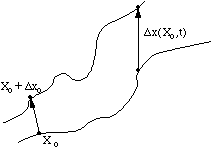 Consider two points in a space
Consider two points in a spaceThe Chaos Hypertextbook™
© 1995-2003 by Glenn Elert
All Rights Reserved -- Fair Use Encouraged
Standard map orbits rendered with Std Map
Descriptions of the sort given in the last paragraph are unnatural and clumsy. It would be nice to have a simple measure that could discriminate among the types of orbits in the same manner as the parameters of the harmonic oscillator.
 Consider two points in a space
Consider two points in a space
X0 & X0 + Dx0
each of which will generate an orbit in that space using some equation or system of equations. These orbits can be thought of as parametric functions of a variable that is something like time. If we use one of the orbits a reference orbit, then the separation between the two orbits will also be a function of time. Because sensitive dependence can arise only in some portions of a system (like the logistic equation), this separation is also a function of the location of the initial value and has the form Dx(X0, t). In a system with attracting fixed points or attracting periodic points, Dx(X0, t) diminishes asymptotically with time. If a system is unstable, like pins balanced on their points, then the orbits diverge exponentially for a while, but eventually settle down. For chaotic points, the function Dx(X0, t) will behave erratically. It is thus useful to study the mean exponential rate of divergence of two initially close orbits using the formula
![]()
This number, called the Lyapunov exponent "l" [lambda], is useful for distinguishing among the various types of orbits. It works for discrete as well as continuous systems.
| l < 0 [lambda] |
The orbit attracts to a stable fixed point or stable periodic orbit. Negative
Lyapunov exponents are characteristic of dissipative or non-conservative
systems (the damped harmonic oscillator for instance). Such systems exhibit
asymptotic stability; the more negative
the exponent, the greater the stability. Superstable fixed points and superstable
periodic points have a Lyapunov exponent of |
| l = 0 [lambda] |
The orbit is a neutral fixed point (or an eventually fixed point). A Lyapunov exponent of zero indicates that the system is in some sort of steady state mode. A physical system with this exponent is conservative. Such systems exhibit Lyapunov stability. Take the case of two identical simple harmonic oscillators with different amplitudes. Because the frequency is independent of the amplitude, a phase portrait of the two oscillators would be a pair of concentric circles. The orbits in this situation would maintain a constant separation, like two flecks of dust fixed in place on a rotating record. |
| l > 0 [lambda] |
The orbit is unstable and chaotic. Nearby points, no matter how close, will diverge to any arbitrary separation. All neighborhoods in the phase space will eventually be visited. These points are said to be unstable. For a discrete system, the orbits will look like snow on a television set. This does not preclude any organization as a pattern may emerge. Thus the snow may be a bit lumpy. For a continuous system, the phase space would be a tangled sea of wavy lines like a pot of spaghetti. A physical example can be found in Brownian motion. Although the system is deterministic, there is no order to the orbit that ensues. |
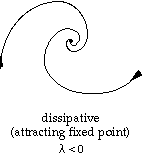 |
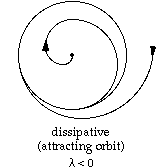 |
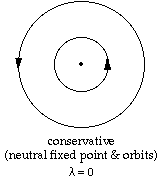 |
In the diagram below we can see both stable and unstable orbits as exhibited in a discrete dynamical system; the so-called standard map also known as the Cirikov-Taylor map. The closed loops correspond to stable regions with fixed points or fixed periodic points at their centers. The hazy regions are unstable and chaotic.
Sample Orbits of the Standard Map
(x, y) --> (x + y, y - 0.971635 sin (2px)/2p)
Different orbits are assigned different colors.
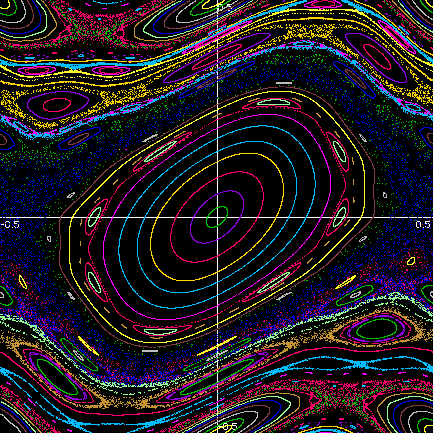
An interesting diversion. Take any arbitrarily small volume in the phase space of a chaotic system. Adjacent points, no matter how close, will diverge to any arbitrary distance and all points will trace out orbits that eventually visit every region of the space. However, the evolved volume will equal the original volume. Despite their peculiar behavior, chaotic systems are conservative. Volume is preserved, but shape is not. Does this also imply that topological properties will remain unchanged? Will the volume send forth connected pseudopodia and evolve like an amoeba, atomize like the liquid ejected from a perfume bottle, or foam up like a piece of Swiss cheese and grow ever more porous? My feeling is that the topology will remain unchanged. The original volume will repeatedly fold in on itself until it acquires a form with infinite crenelated detail. End of diversion.
Given this new measure, let's apply it to the logistic equation and see if it works. The limit form of the equation is a little too abstract for my skill level. Luckily an approximation exists. The Lyapunov exponent can also be found using the formula
![]()
which in the case of the logistic function becomes
![]() where
where ![]()
This number can be calculated using a programmable calculator to a reasonable degree of accuracy by choosing a suitably large "N". I calculated some Lyapunov exponents on a programmable calculator for interesting points on the bifurcation diagram. The results are listed in the table below and agree with the orbits.
| r | l [lambda] | comments |
|---|---|---|
| 1 | 0-0.005112... | start stable fixed point |
| 1.99 | 0-6.643... | |
| 1.999 | 0-9.965... | |
| 2 | calculator error* | superstable fixed point |
| 2.001 | 0-9.965... | |
| 2.01 | 0-6.643... | |
| 3 | 0-0.003518... | start stable 2-cycle |
| 3.236067977... | -19.43...* | superstable 2-cycle (1 + sqrt(5)) |
| 3.449489743... | 0-0.003150... | start stable 4-cycle (1 + sqrt(6)) |
| 3.5699456720 | 0-0.002093... | start of chaos (Hofstadter) |
| 3.56994571869 | 0+0.001934... | start of chaos (Dewdney) |
| 3.828427125... | 0-0.003860... | start stable 3-cycle (1 + sqrt(8)) |
| 3.9 | 0+0.7095... | back into chaos |
| 4 | 0+2 | end of chaos |
| *Analytically, |
||
You can see there was some disagreement in the sources as to exactly where the chaotic regime begins. Note also that because the calculator can only approximate the value of 1 + sqrt(5), the Lyapunov exponent for the superstable 2-cycle is only a relatively large negative number and not negative infinity as expected.
Speaking of disagreement, the Scientific American article that got me started on this whole topic contained the following paragraph:
I encourage readers to use the algorithm above to calculate the Lyapunov exponent for r equal to 2. Then compare the result with that obtained when r = 3. The first number should be negative, indicating a stable system, and the second number should be positive, a warning of chaos. (Dewdney 179)
Well, I tried those numbers in the equation
![]() where
where ![]()
but I kept getting an error message from r = 2. Stupid me, I spent several minutes looking for an error in the code not realizing that the mistake was in the instructions. At this "r" value the system quickly settles on to the fixed point of 1/2, which makes
r - 2rx = (2) - 2(2)(1/2) = 0
No calculator can find the logarithm of zero and so the program fails. The logistic equation is superstable at this point, which makes the Lyapunov exponent equal to negative infinity (the limit of the log function as the variable approaches zero).
There is a second error in the statement that r = 3 is in the chaotic regime. This is actually the location of the first bifurcation. Fact checking is vital when writing for an audience of more than one. Have you found the errors in this book yet?
| Another quality webpage by Glenn Elert |
 |
home | contact bent | chaos | eworld | facts | physics |